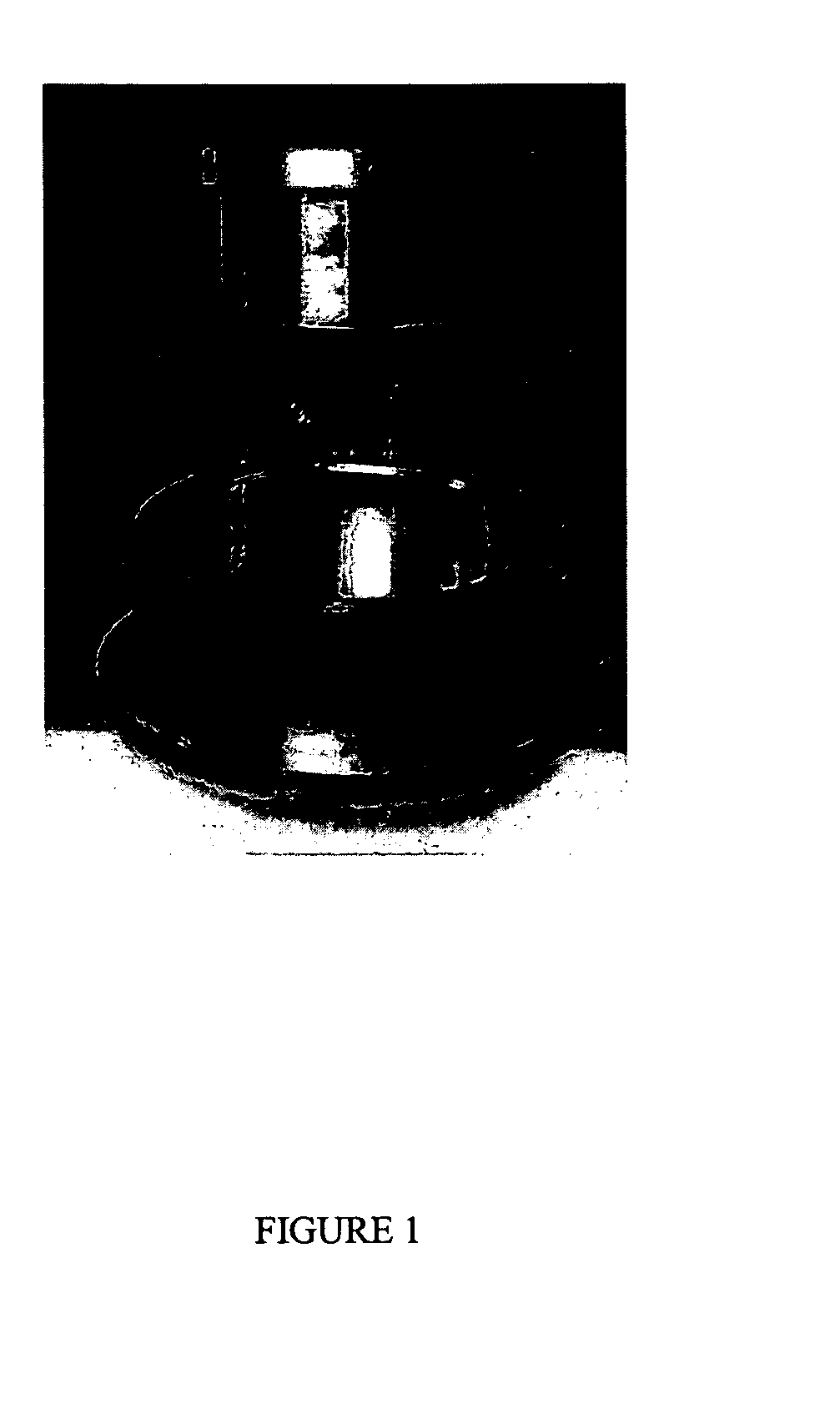Methods for making and using composites, polymer scaffolds, and composite scaffolds
a technology of composites and scaffolds, applied in the field of methods for making and using composites, polymer scaffolds, composite scaffolds, etc., can solve the problems of preventing the applicability of many procedures, non-organic solvent based methods known to the art, complex requirements for making composites and scaffolds for implantable devices, etc., to achieve easy manipulation, avoid time-consuming and costly post fabrication processing, and ensure the effect of safety
- Summary
- Abstract
- Description
- Claims
- Application Information
AI Technical Summary
Benefits of technology
Problems solved by technology
Method used
Image
Examples
example 1
[0050] This example describes the preparation of a composite of inorganic particles embedded within the outer regions of a thermoplastic polymer solid using thermal compression molding.
[0051] First, a solid polymer sheet of 85:15 poly(DL-lactide-co-glycolide) (PDLGa) which is a resorbable polymer with known biocompatible characteristics having an approximate thickness of 0.7 mm and a diameter of 37 mm was made by thermal compression molding. Specifically, one gram of the polymer was placed between ferrotype plates along with a 0.75 mm spacer cavity and heating on the lower plate of an Autoseries Carver press for three minutes at 300° F. The pre-heated polymer was then pressed between the plates for forty-five seconds at 48,0000 pounds at the same temperature of 300° F. After cooling the polymer sheet was removed from the ferrotype plates.
[0052] To make the hydroxyapatite / polymer composite, 5 g of hydroxyapatite (HAp) powder was placed in the bottom of a confined stainless steel mo...
example 2
[0054] This example describes the preparation of a homogeneous composite of inorganic particles embedded entirely throughout a thermoplastic polymer solid using thermal compression molding.
[0055] A 0.7 mm thick / 37 mm diameter sheet of 85:15 PDLGa polymer was prepared as described in Example 1 above. To make the silica / polymer composite, 20 g of silicon dioxide, in the form of play sand as a model material, was place in the bottom of a confined stainless steel mold having an inner diameter of 50 mm and wall thickness of 5 mm (FIG. 1). The 0.7 mm thick / 37 mm diameter compression molded polymer sheet was place on top of the layer of silica and then another 20 g of silicon dioxide was layered on top of the polymer sheet. The plunger of the confined mold was placed on top and the materials were compressed using a 2 stage procedure. The first stage of compression was carried out at 360° F. at 1,000 pounds of pressure for 8 minutes. Next, the materials were compressed further under 10,000...
example 3
[0057] This example describes the preparation of a composite of inorganic beads embedded within one surface of a thermoplastic polymer using thermal compression molding.
[0058] A 0.7 mm thick / 37 mm diameter sheet of 85:15 PDLGa polymer was prepared as described in Example 1. To make the barium sulfate / polymer composite, 12 g of sodium chloride (sieved to diameter range of 425-710 um), was placed in the bottom of a confined stainless steel mold having an inner diameter of 50 mm and wall thickness of 5 mm (FIG. 1). The 0.7 mm thick / 37 mm diameter compression molded polymer sheet was place on top of the layer of sodium chloride and then 9 g of barium sulfate beads were layered on top of the polymer sheet with an additional 10 g of salt placed on top of that. The plunger of the confined mold was placed on top and the materials were compressed using a 2 stage procedure. The first stage of compression was carried out at 360° F. at 1,000 pounds of pressure for 8 minutes. Next, the material...
PUM
| Property | Measurement | Unit |
|---|---|---|
| diameter | aaaaa | aaaaa |
| thickness | aaaaa | aaaaa |
| temperature | aaaaa | aaaaa |
Abstract
Description
Claims
Application Information
 Login to View More
Login to View More - R&D
- Intellectual Property
- Life Sciences
- Materials
- Tech Scout
- Unparalleled Data Quality
- Higher Quality Content
- 60% Fewer Hallucinations
Browse by: Latest US Patents, China's latest patents, Technical Efficacy Thesaurus, Application Domain, Technology Topic, Popular Technical Reports.
© 2025 PatSnap. All rights reserved.Legal|Privacy policy|Modern Slavery Act Transparency Statement|Sitemap|About US| Contact US: help@patsnap.com



